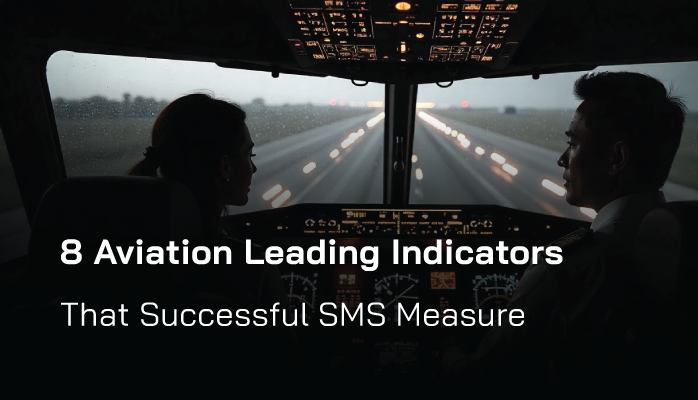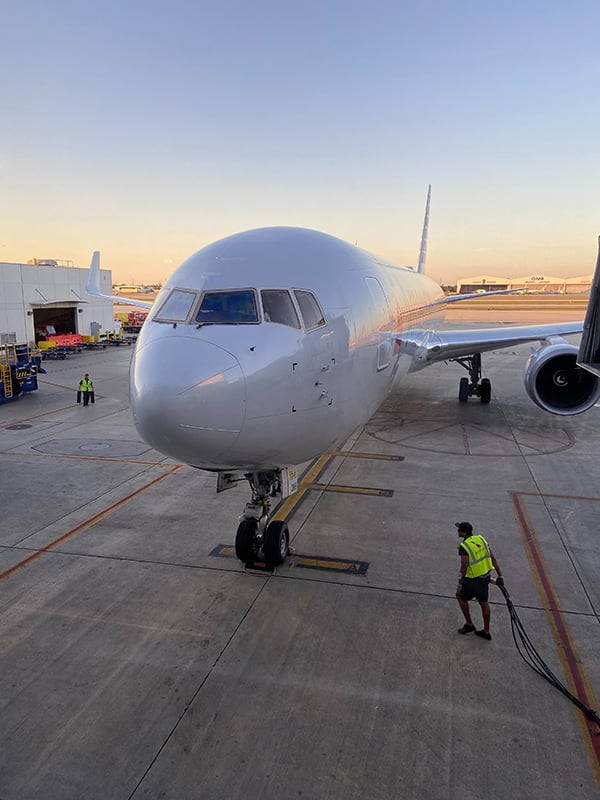Why Successful SMS Live by Aviation Leading Indicators

Aviation leading indicators are aviation safety data put to best use. They are designed to identify precursors to good/bad safety performance and uncover what goes into the program that dictates success or failure.
Successful aviation safety management systems (SMS) are primarily concerned with stopping the manifestation of hazards before they happen, which is why they depend so much on leading indicators.
Leading indicators in aviation become useful to safety programs when:
- That program is nearing full SMS implementation;
- Safety performance begins to plateau; and
- Existing safety metrics (usually lagging indicators), no longer provide enough feedback about why safety happens as it does.
Adopting, developing, and making use of leading indicators is currently the final step aviation SMS needs to take in order to create a best-in-class safety program. Here are 8 aviation leading indicators that successful SMS programs keep tabs on.
Related Aviation Leading Indicators Articles
- What Are Leading Indicators in Aviation SMS?
- How to Use Leading Indicators in Aviation SMS
- 7 Tips to Find Leading Indicators in Aviation SMS
1 – % Employees Who Can Access Aviation Safety Training in Native Language
Aviation safety training is a cornerstone of building employee skills, confidence, and abilities required of high functioning aviation SMS. It’s also a fact that the aviation industry features a diverse, multicultural employee base.
This is especially true of pilots and airports' front-line employees, many of whom speak English as a second language. When such employees can’t access safety training in their native language:
- They may only understand a portion of the training;
- They may miss important cues or learning points; or
- They may understand very little to none of the training.
This metric is important as a leading indicator because it’s extremely indicative of where risk breakdowns may occur because of communication issues.
2 – Frequency of Safety Meetings

Of all aviation leading indicators, this one is near the top. The correlation between safety meetings and safety incidents is dramatic. It’s absolutely clear that the greater the frequency of aviation SMS safety meetings, the less frequent work accidents are. See the graph to the right, which is taken from a report by ABS:
This metric is fantastic as a leading indicator because it’s a great precursor measurement for how many accidents you can expect to occur. Importantly, it’s a precursor you have control over. Identifying and analyzing leading indicators should be one of your aviation SMS' predictive risk management activities.
Ideally, the more people you are able to involve in safety meetings, the better.
As more people participate in safety meetings, your safety culture improves.
As your safety culture improves, employees report more safety concerns.
As you have more safety data to analyze, you can more effectively engage in this predictive risk management activity. When safety teams possess more relevant hazard reporting data, your leading indicator analysis becomes more accurate and valuable in predicting operational areas to focus your risk management activities.
Related Articles on Aviation SMS Predictive Risk Management
- Difference Between Reactive, Predictive and Proactive Risk Management in Aviation SMS
- How to Practice Reactive, Proactive, and Predictive Risk Management in Your Safety Program
- How Aviation Safety Managers Reach Predictive Analysis Phase
3 – % SMS Training Courses Featuring End-of-Course Assessment
Consider one question about your safety program: how do you know if your safety training is working? While there are correlations you can draw between safety and training, end-of-course assessments are a much more direct way of establishing how effective safety training is.
End-of-course assessments allow you to:
- Track a valuable portion of each employee’s safety performance;
- Ensure that training courses are effectively communicating information; and
- Confirm that money spent on training is not being wasted.
When assessment scores are high, you can expect that employees are reentering the workplace much better prepared than they were before the training. As a result, better safety responses and fewer accidents are expected.
4 – % Employees’ Performance Review That Is Safety Related
While it would be great if employees could care about their aviation SMS for the sake of safety, this is terribly unrealistic. They have to have personal stakes in the program.
Safety performance reviews need to be considered in conjunction with regular performance duties. Otherwise, what real incentives do employees have to care about their personal involvement in the safety program? This is a great leading indicator of how active employees will be in their safety program. It:
- Requires tracking safety performance metrics for individual employees, such as number of reported issues, attending meetings, etc.;
- Should be mixed in with regular performance reviews, and NOT be conducted as a separate (i.e., less important) review; and
- Should measure a percentage of how many tracked performance points are safety-related.
For example, if 4 of the 10 performance review points were safety-related, then this metric would be 40%.
Have You Read
- Why Employees Don't Care About Your Aviation SMS
- How to Reduce Resistance to Aviation SMS Programs With Difficult Employees
- 4 Tips to Monitor Employee Safety Performance in Aviation SMS
5 – % Employees With Over 5 Years Employment at Company

5 years at a company is an important marker. It means that an employee has reached the highly touted 10,000-hour mark. At this point, an employee should have “veteran” status and:
- Thoroughly knows his/her duties, responsibilities, and procedures;
- Has had enough experience to be thoroughly familiar with the safety program;
- Will have (ideally) completed all training courses (perhaps several times); and
- Has had enough time to experience the safety trends and recognize precursors to safety events.
Depending on your organization, you may change the number of years this metric measures. The point is that the greater the percentage of veterans that are employed in your company, the more likely hazards are identified earlier and risks are avoided before they materialize.
On a contrary note, the percentage of veterans could indicate the opposite. Many employees resist change. This becomes more evident with the older veterans who have been performing the same tasks for decades and are comfortable with the status quo. Whenever I see an aviation-related company with most managers in their 50s or 60s, I immediately become concerned over their ability to wholeheartedly accept the tenets of SMS.
Older employees have witnessed equipment damage and injuries for many years and may believe this is the "cost of doing business." "We've always paid $350,000 each year for hangar rash, so we just set aside $350,000 each year to account for this loss." You can see the problem with this logic and how it affects safety culture and the attitudes of other employees in the SMS.
Continuous improvement of the SMS is impossible when the older veterans resist changing their mindsets and accepting that there "might" be better risk management strategies.
6 – Average Turnover Rate Per Year
New employees pose some of the greatest risks to an aviation risk management program. This holds true even when they have previous experience in their newly assigned position. New employees may be unfamiliar with:
- Particular hazards, risks, and controls in your environment;
- Procedures, expectations, and workflows of your safety program; and
- Relationship dynamics and strengths/weaknesses of other employees they work with.
In short, the more new employees, the greater an organization is exposed to risk. Low turnover means fewer new employees and less exposure. Thus, this leading indicator of aviation is a great precursor to risks. Higher turnover requires organizations to be more vigilant, and investigate the underlying causes of the high turnover.
7 – % Jobs That Have Checklists
Checklists increase safety. Period. Checklists are a documentable way to:
- Quantifiably track the effectiveness of how each job is completed;
- Standardize the safety of performing duties;
- Give employees guidance on performing duties safely; and
- Assuring management that complex tasks are being performed in a prescribed manner.
The more jobs that have checklists, the more an aviation SMS can impose controls on quality and safety performance. A common audit question is whether employees are conforming to prescribed procedures in certain hazardous workplace settings. An audit finding should be documented when auditors discover employees
- neglecting prescribed checklists entirely; or
- taking shortcuts to circumvent checklist procedures.
Related Aviation SMS Audit Articles
- How Often Should You Conduct Aviation SMS Audit
- 5 Ways to Prepare for Aviation SMS Audits
- How to Create an Aviation SMS Audit Plan
8 – Average Number of Days to Complete CPAs / Close Issues by Risk Level
Average days to complete assigned safety tasks is a fantastic measurement of management’s performance. Moreover, it’s a clear indicator of what management’s performance will be like in the future. It’s indicative of safety performance in actively managed areas of the SMS. Assigned safety tasks may include, but are not limited to:
- Reported safety concerns;
- SMS implementation activities;
- Accident and incident investigations;
- Audits, inspections and evaluations;
- Implementing corrective actions and preventive actions;
- Hazard monitoring and review;
- Management of change initiatives;
- Publishing safety newsletters and other safety communications; and
- Administering safety surveys.
The point of this aviation leading indicator is that if management is slow to complete the most basic safety management tasks – managing issues and corrective actions – then they will likely be slow in many other areas of SMS as well. Measuring and monitoring these activities provides management with useful metrics to establish SMS goals and objectives.
This list of leading indicators is not all-inclusive. There may be many more leading indicators that an imaginative safety manager may adopt to supplement the SMS' predictive risk management repertoire.
If you have found this list helpful, you will surely find the full list of 40 aviation leading indicators very useful:
Last updated September 2025.





